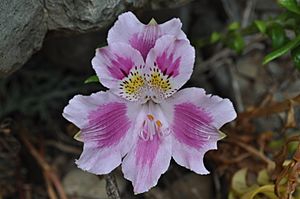Peruvian lily facts for kids
Quick facts for kids Peruvian lily |
|
|---|---|
 |
|
| Alstroemeria pelegrina | |
| Scientific classification | |
| Genus: |
Alstroemeria
|
| Species: |
pelegrina
|
| Synonyms | |
Alstroemeria pelegrina, also known as the Peruvian lily, is a beautiful flowering plant. It belongs to a big group of plants called Alstroemeria, which are also known as Inca-lilies. This plant was first described by a famous scientist named Carl Linnaeus in 1762. It's a plant that grows back every year (a perennial) and has special underground stems called rhizomes. You can only find it growing naturally in Chile.
Contents
What Does the Peruvian Lily Look Like?
The stems of the Peruvian lily can grow from about 20 to 60 centimeters (8 to 24 inches) tall. The upper part of the stem is smooth, while the lower part has small scales.
Roots and Leaves
Under the ground, this plant has rhizomes. These are like long, thin underground stems that branch out. They also have long, thin roots attached to them.
The leaves are a bright green color. They grow in a spiral pattern around the upper part of the stem. They are also twisted so their tips point to the side.
Flowers and Seeds
The flowers of the Peruvian lily are large and very colorful. Each flower has petals and sepals that look similar, called tepals. These tepals are about 4.5 to 5.5 centimeters (1.8 to 2.2 inches) long.
They are a bright pink color with a purple center. Inside the flower, the stamens (which hold pollen) have purplish tips. The part of the flower that holds the seeds is smooth and has six clear ridges. Once the flowers are done, the plant produces brown, round seeds.
How Scientists Named This Plant
The group of plants called Alstroemeria was first described by Johan Peter Falk and his teacher Carl Linnaeus. This happened in 1762 in a paper called Planta Alströmeria.
They described three different species, and A. pelegrina was one of them. Because Linnaeus was the first to officially describe it, his name (L.) is added after the plant's scientific name. A. pelegrina was the first species described in this group, so it is known as the type species for the whole Alstroemeria genus.
Where Does the Peruvian Lily Grow?
The Alstroemeria pelegrina plant is native to (only found naturally in) certain parts of Chile. These areas are called the Norte Chico and central regions. It can also be found in Peru.
Specific Locations
You can find it growing between Los Vilos and Punta Curaumilla in Chile. This area has a Mediterranean littoral climate, which means it's a coastal region with mild, wet winters and hot, dry summers.
A very large group of these plants lives along the coast between Los Molles and Pichidangui. Here, people sometimes call it mariposa de Los Molles, which means "Los Molles butterfly." This plant loves to grow on rocks and cliffs right along the coast, close to the high tide line.
Life Cycle and Blooming
The Alstroemeria pelegrina blooms every year. Its beautiful flowers appear between October and December. After the flowers bloom, the plant starts to produce fruit, which usually appears after the end of October.
Protecting the Peruvian Lily
Alstroemeria pelegrina is one of nine plant species in its area that are considered vulnerable. This means they are at risk of disappearing.
The main threats to these plants are tourism and new buildings. As more homes and roads are built, they cut through the plant's natural home, making it harder for them to survive.
Growing Peruvian Lilies
Alstroemeria pelegrina was the very first Alstroemeria species to be brought to Europe. This happened way back in 1744, and people started growing it there.
This plant is quite tough and can grow in USDA zones 10a–11. In the United States, it is grown in states like California, Louisiana, Texas, and Florida.
See also
 In Spanish: Alstroemeria para niños
In Spanish: Alstroemeria para niños

